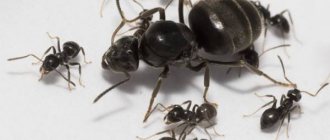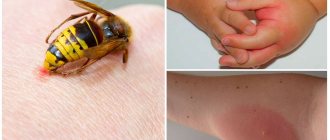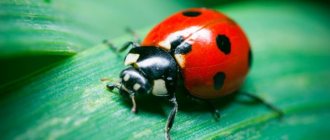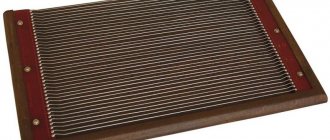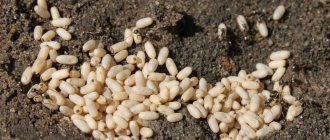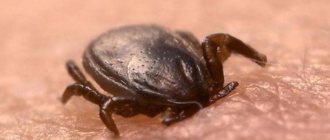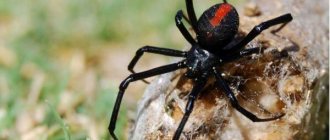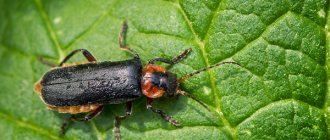Traditionally, people think of a wasp as an insect with yellow and black stripes on its abdomen. But the huge number of species of representatives of the suborder of stinging stalked bellies presents surprises in the form of individuals of various colors and sizes. The black wasp is a pompilidae (road wasp), members of this family are medium to large in size. Their prey is spiders, but the poisonous stings of insects are dangerous to humans. An allergic reaction and pain at the bite site lasts 2-3 days.
Description of appearance
Black wasp is medium or large in size – 15-50 mm.
Dark head, chest, abdomen with stripes and spots of yellow, white, red, purple. The wings are dull, smoky, folded parallel to the body. The legs are long, thin, and have digging ridges on the front legs. Hind tibia with spines and tubercles. On the small head, eyes and small antennae are clearly visible. Pompilids have a powerful sting, with which they calmly pierce the shell of large insects and their larvae. A photo of a black wasp is presented below. The color varies depending on the species.
Red-bellied road wasp (Anoplius viaticus)
Distributed in central Eurasia. The length of the body of this wasp is from 6 to 15 mm. The chest of the red-bellied black wasp is black in color, its base is covered with felt formed by light short hair. The abdomen is red on the front side, with black stripes. The female of this wasp species preys on the wolf spider . Before hunting, she digs a nest, into which she then drags the paralyzed victim and lays an egg on it.
Crossbill wasp (Batozonellus lacerticida)
The black wasp is large in size, with an average length of 10–21 mm. The body is covered with yellowish spots, the limbs are predominantly yellow-orange, the wings are dark with yellowishness, framed at the edges by a dark border. These wasps hunt, as you might guess from the name, cross spiders. The nests into which they drag the prey are made in the sand. This individual is distributed throughout almost the entire territory of extratropical Eurasia to Japan to the east and in North Africa.
Dipogon hircanum
This wasp is 0.5-1 cm long and has a completely black color. The front wings have a dark spot in the upper corner. The object of hunting for females of this species of wasps are side-walking spiders that live in trees. They create nests in the inner part of shoots or stems. They live everywhere in extratropical Eurasia, east to Japan and Kamchatka.
The largest wasp in the world
Herbaceous plants: description, diversity and types
The size of the wasps varies widely: from 1 cm for the small flower wasp to 6 cm for the Asian giant scolius.
The spotted wasp Scolia is considered the beauty among the largest representatives of the Hymenoptera. The body size of the largest wasp is 32 mm for the male and 55 mm for the female.
Insects lead a solitary, primitive way of life. Scolia, with its impressive dimensions, is harmless to humans, although the bite can cause the hand to go numb.
The hornet from Asia is a giant copy of the European representative, but without a brownish tint in color: the body is up to 50 mm long, the amplitude of the wings reaches 60 mm. The named hornet wasp has a terrifying appearance. In common parlance, the hornet is called a sparrow-bee.
Habitats
The black wasp in Russia is found in the forest, in fields, along roads, in personal plots, in gardens, and in vegetable gardens. The main criterion for choosing habitats is soil. It should be loose enough for digging, not loose, so that the minks do not collapse. Most often it is a mixture of sand, clay, and limestone.
On a note!
The black wasp often settles near a person’s house, but it is quite difficult to spot a single insect. In the garden, the insect brings benefits by destroying spiders, flies, and pollinating plants.
Lifestyle
The black wasp is a solitary species. Queens do not create large nests, as paper wasps do, do not swarm, and do not transmit signals to other individuals. In spring, they lead a carefree lifestyle, flying around the area, collecting nectar. They spend the night on plants, grass, and old tree hollows.
Closer to summer, female black wasps begin to take care of procreation. Minks are dug in the ground, about 3 cm deep. At the end of the tunnel, a single cell is formed in which the larva will develop. He closes the entrance to the hole with a pebble or a pile of earth and goes hunting.
Spiders are often potential victims. The female paralyzes them with powerful poison and drags them into a prepared hole. Lays an egg in the body and closes the entrance. After a few hours, a larva appears and will eat the spider alive for 14 days. At the end of the development cycle, it forms a cocoon. A few days later, the imago crawls out of the ground. The larvae, which develop at the end of summer, remain overwintering in the pupal state.
For each larva, the black wasp forms a separate burrow. Sometimes it uses ready-made passages made by other insects, as well as old tree hollows.
On a note!
Solitary ground wasps are called versatile, powerful predators. Often their victims are poisonous spiders and bedbugs.
How it feeds and reproduces
The main diet of black wasps consists of:
- small, often poisonous spiders;
- bedbugs;
- large flies;
- larvae of other insects.
As mentioned earlier, the breeding season occurs in the warm season - spring or summer. Unlike most representatives of Hymenoptera, the queen lays eggs in special depressions of three to four centimeters. For this, only loose soil or rotten, soft wood is used.
A nest with black wasp larvae is often found near a person. For example, this could be a garden or vegetable garden.
The larvae eat the same things as the mature representatives. Food is supplied by the female, who paralyzes her victims with poison. Only one larva lives in one hole.
What do pompylids eat?
Pompylids feed on various insects, but mainly on spiders, which are larger in size than themselves. This is due to the fact that this type of wasp has the strongest and most developed sting, unlike other wasps. In addition, road wasps developed their food extraction tactics very carefully and thoughtfully. They direct their sting to the point where all the nerve endings of the spiders, which are responsible for controlling the limbs and abdomen, are concentrated. Therefore, the road wasp can very easily and accurately neutralize its prey.
But before this, the wasp must plunge its stinger into the spider’s oral cavity in order to neutralize the poisonous chelicerae located in it. If a wasp wants to eat a spider living in a hole, then before grabbing it, it must drive it to the surface. In its hole, the spider feels very comfortable and confident, but when it comes out into the light, it becomes weak and defenseless, which helps the hungry wasp to easily grab and neutralize the spider. After the prey is paralyzed, the wasp leaves it for a while to find a suitable place to store it.
Wasp bites or stings
The insect uses its sting in case of danger to its own life or during hunting to paralyze the victim. After piercing the chitin or skin, the wasp quickly lets in a toxic substance.
However, if it is possible to do without poison, the insect uses its powerful jaws. They have no teeth, but are strong enough to bite through the chitinous covering of beetles. Wasps try to save poison and use their weapons in emergencies. In a fight with a person, insects always use a sting for protection, which is why the statement arose that the wasp stings. The word “bites” refers to precisely this process.
Reproduction of pompilids
Large black wasps are solitary; they do not live in colonies and do not build multi-tiered nests. A place for offspring is chosen in the ground, not far from well-trodden roads. Females do not feed the larvae, bringing them food daily. The offspring grows independently, on “live canned food”. Road wasps do not make honeycombs; they use several separate larval chambers as nests. These are short passages dug into the ground, ending in a slight widening.
Information. Some species of pompilids make nests in plant cavities or make them out of clay.
During the breeding season, the female finds and immobilizes spiders on which the larvae will feed. First, she immobilizes the victim, and then looks for a suitable place to burrow. While digging a nest, the female periodically returns to the spider, because it is stolen by ants or other wasps. Next begins the difficult stage of dragging the arthropod into the hole. Some specimens of spiders exceed the size of pompilids.
Larra anathema wasp
These wasps are highly valued by gardeners, as they are assistants in the destruction of mole crickets. Larra anathema is a solitary wasp. It has a black color. When Larra Anathema finds a mole cricket, she drives it to the surface and paralyzes it there with three targeted sting strikes in certain places on the body. After this, the wasp lays an egg under the front leg of the victim.
Larra anathema wasp laying an egg as a victim.
After 5 minutes, the paralysis passes, and the mole cricket climbs underground, continuing to lead its usual lifestyle. The larva of a burrowing wasp emerges from the egg and develops in about 30 days, during which it molts 5 times. All this time, the larva lives as an external parasite on the body of the mole cricket. The mole cricket dies shortly before the larva pupates.
Why is the black wasp dangerous?
Road wasps provide benefits by killing spiders and other pests. The harm they cause is bites inflicted for the purpose of self-defense. Although attacks on humans are rare, each one is very painful and dangerous for people prone to allergies.
Attention. Pompylids have a powerful sting and toxic venom. Because of the painful reaction, a black wasp sting has been compared to a red ant sting.
The introduction of a paralytic toxin will not immobilize a person, but will cause a severe allergic reaction. After a bite, it is necessary to disinfect the wound with an antiseptic. Among the recommendations:
- Apply a cold compress (ice) and hold until the swelling subsides.
- Drink plenty of fluids that help eliminate toxins - water, weak tea, Regidron solution.
- Stop drinking alcoholic beverages.
- If an allergic reaction occurs, take an antihistamine. People prone to allergies should go to the hospital.
Wasps - masters of paperwork
Among all the species that inhabit our planet, wasps are characterized as the most skilled paper craftsmen.
True, not all wasps build their magnificent houses from paper pulp, which is obtained by chewing wood. However, the well-known striped robbers, which many people with a sweet tooth have been afraid of since childhood, belong specifically to the family of so-called paper wasps, or more precisely to two biological families, similar in biological characteristics - vespins and polystines.
The wasps of these two families lead a social lifestyle, which forces them to build rather large nests that would provide shelter to all members of the wasp community. At the same time, the multi-apartment wasp house must be dry and warm, because, like all hymenoptera, wasps are afraid of high humidity, which weighs down their transparent porches and does not allow them to take off.
How to get rid
A wasp sting is most dangerous for children and people with individual intolerance. If the insect nest is located close to your home, then it is better to get rid of it. This can be done both with the help of chemicals and using a mechanical method of control.
Chemical control
Most often, chemicals can be found in aerosol form. The concentrated insecticide does not poison the ground and is practically safe for people.
Most Popular:
- Moskitol. It is necessary to spray strictly in an open space. If you need to spray the hole, then reduce the dose by 2-3 times.
- Gett. A powerful, odorless drug. It has a long-lasting effect, as it remains active for 5-6 months after spraying.
Karbofos and Troapsil are no less popular.
Physical methods
The nest should be removed from the property wearing a protective suit or after pre-treating the area with chemicals. If the nest is located in the ground, then you can dig up the area and pour boiling water over it.
When it is necessary to lure out adults, sweet traps are used. They are made from a plastic bottle and compote or fruit juice. The bottle is cut in half and the upper part is placed neck down into the lower part, where the sweet liquid is poured.
Folk remedies
The Russian people have come up with many tricks to catch and destroy any wasps. The most famous, perhaps, are simple traps.
Bait trap
To create it you will need a large plastic bottle and 200 ml of sweet, sour compote or at least fruit juice.
- Cut the bottle along the bend in the middle.
- Pour the prepared solution into the bottom of the bottle, turn the top upside down and place it in the top.
Thus, it serves as a kind of limiter, allowing the wasp to fly in without the ability to slip out.
Scolia wasps - description
Scolia wasps are a family of about 560 species, and members are found throughout the world. Insects are dark in color, often with a metallic sheen. They are relatively large in size, strong, slightly hairy. Males are slimmer and longer than females, with significantly longer antennae. The entire body is black with light yellow spots, stripes or other markings.
The wings of the Scolia wasp are dark blue, which is why it is sometimes called the blue-winged wasp. An adult is more than 3.5 centimeters long. There are also giant representatives of the species that are 4.5 centimeters long. Distinctive features of this wasp are black antennae, a shiny black head, thorax and abdomen. There are two yellow spots or stripes about the middle of the abdomen; when the wasp flies, these may appear as a stripe across the abdomen. The back of the abdomen is sometimes brownish.
Scolia wasp. Gokhan ERENHow dangerous is an insect and its poison?
The bright yellow color is a warning. It gives predators the information that this order of insects is poisonous and can pose a serious threat to the attacker.
The venom of one wasp does not paralyze an adult, but can cause an allergic reaction. It is indicated by the following symptoms, which appear within an hour after the poison enters the body:
- severe itching;
- skin rash;
- burning at the site of the bite.
So, doctors identify four possible outcomes after a bite:
- A common local or non-allergic reaction. Symptoms pass quickly: from a couple of hours to one day. Least painful.
- Severe local allergic reaction. Swelling with a radius of five centimeters lasts for 24 hours or more. Usual symptoms are accompanied by inflammation of the lymph nodes, a sharp increase in temperature, and headache.
- General allergic reaction. In addition to the usual feeling of malaise, severe swelling, nausea, diarrhea, and shortness of breath are added. Possible abdominal pain, panic attacks and bluish discoloration of the bite site, or cyanosis.
- General toxic or non-immunological reaction. The formation of blood clots in the vessels, sudden destruction of muscle tissue, hemolysis or disruption of the myocardium, the main muscular part of the heart, are observed.
In rare cases, a bite can cause anaphylactic shock, accompanied by a sharp decrease in blood pressure. It is especially dangerous for children, the elderly and pregnant women and can even be fatal.
What to do if you are stung by a road wasp?
If, nevertheless, you did not please the road wasp in some way (maybe it did not like your perfume or behavior), and it stung you, try to do the following: take a painkiller and an antihistamine. The pain from the bite is very severe and can last up to 72 hours. People with a low pain threshold may even develop a state of shock. In addition, the poison that the wasp injects into its victim causes severe tissue swelling and allergic reactions. It is especially dangerous when the bite occurs in the neck or head area. Therefore, after a bite you should immediately consult a doctor.
We in no way want to scare anyone with our article. The likelihood of encountering this Maya bee in Thailand is quite low. In any corner of our planet you can always find some unpleasant creature. We just want to convey to readers the idea that when going on a trip to Thailand, it is worth remembering that this is a country with tropical nature, which is as beautiful as it is harsh with those who neglect it.
Rules for first aid for a bite
Timely assistance is divided into the following stages:
- Disinfecting hands with soap.
- Rinse the wound itself under slightly cold water to prevent dirt from getting inside.
- Disinfecting the bite site, for example, with hydrogen peroxide.
- Apply a compress in the form of a piece of cloth soaked in slightly cold water.
- Taking any antihistamine: Supradin, Zodak, Erius, taking into account contraindications and dosages specified in the instructions.
In addition to special medicinal products, lotions made from tea, onion or plantain are very effective for relieving swelling.
Interesting! Contrary to popular belief, unlike a bee, a wasp does not leave a sting after stinging.
If several wasps attack at once, or if, after being bitten by one individual, the symptoms do not go away or intensify within several days, you should immediately consult a doctor. Even after apparent complete recovery, a visit to a local clinic is recommended.
Who destroys wasp nests in the ground
What are wasps afraid of?
Nests located in the ground can be destroyed by larger animals or birds, as well as some amphibians (although the latter prefer single individuals). Those that eat ground wasps include:
- badgers;
- brown bears;
- honey beetles;
- rats;
- caresses;
- frogs.
Of course, this list is far from complete. In general, the likelihood of a nest being destroyed is largely related to its size - for example, only large animals that are not afraid of bites will approach a large dwelling, and most forest inhabitants will be able to destroy smaller or solitary settlements.
Features of life
Ground wasps begin building nests in the spring at the first warming. Some species settle in sandy soil, while others choose dense soil. Females choose a suitable place.
The wasp digs the ground for its burrow with its paws, which it uses to push the soil away like a shovel. Powerful jaws are involved in the work, and wings help break through dense layers. The insect continuously waves them, the air enters special bags on the chest. The muscles contract, and air is pushed from the sacs through special channels to the jaws. They begin to work with such frequency that a depression is formed with a slight touch to the ground.
Insects can settle in a hole abandoned by rodents, in voids under the soil, near roots and dried trees, in an old anthill.
In the underground dwelling, females build honeycombs in the same way as outside. Chewed wood fibers and saliva produce a mass that, when hardened, looks like paper. From it, the queen builds the first 5–10 cells and lays eggs in them. After 1–1.5 months, larvae appear. The female takes care of them, brings protein food to each cell, and she herself feeds on flower nectar. When the larvae turn into adult insects, they are involved in the construction of a nest for new family members, searching for food, guarding and protecting the home.
By the end of summer, the colony of social wasps reaches its maximum size and numbers several thousand worker wasps and heterosexual individuals ready to reproduce. Only fertilized young females overwinter; the remaining members of the colony die.
Solitary species of ground wasps live separately, building small nests or occupying soil voids for reproduction. The female catches a small insect: a spider, a caterpillar, a fly and paralyzes the victim with poison. It lays an egg on its body and hides its prey in a hole. It will be food for the emerging larva, since the wasp does not care for the offspring. She immediately leaves the dungeon and seals the entrance. Young wasps that have grown from larvae emerge independently in the spring.
Preventive measures
Experts say that black wasps actively consume nectar for a reason. In fact, they are very addicted sweet tooths. If people approach prevention correctly, then it is likely that these insects will never want to occupy their area. First of all, you need to stop putting spoiled food and fruits in one specific place. If they go through the stage of rotting there, they will soon attract the attention of black wasps. Moreover, in this particular case, they will not be the only harmful insects that will wish to visit such a generous “feast”. In such a situation, people will have to look for a lot of ways and means in order to completely cleanse their territory of the wide variety of parasites present on it.
The aroma of flowering plants attracts black wasps very well. First of all, this concerns flowers. That is why it is better to limit yourself in terms of planting flowering plants in the immediate vicinity of a residential building. It should be understood that the black wasp is quite a serious opponent for humans. A positive result in the fight against these insects can be achieved solely through preliminary preparation. Modern preventive measures include thinking through the most effective means and methods of protection. Otherwise, people may suffer from black wasp stings. There is no doubt that absolutely anyone will remember this very painful event for the rest of their lives.
Are wasps capable of producing honey?
Wasps are often compared to bees. A natural question arises: do wasps produce honey? Some types of wasps are capable of making honey. Others don't.
In the cells of wasp honeycombs you can see a small amount of a substance similar to honey. This is nectar collected from plants, processed and has a characteristic floral aroma. But its consistency is different from bee honey; such honey is only suitable for eating by wasps. Insects produce it in such small quantities, which is only enough to feed the insects directly. Therefore, wasp honey is not of interest for beekeeping.
There is a species of wasp in the world whose honey people eat. These wasps live in Mexico and Brazil. The species of wasp received the appropriate name - the Mexican honey wasp. The rural population sometimes uses this honey for food.
